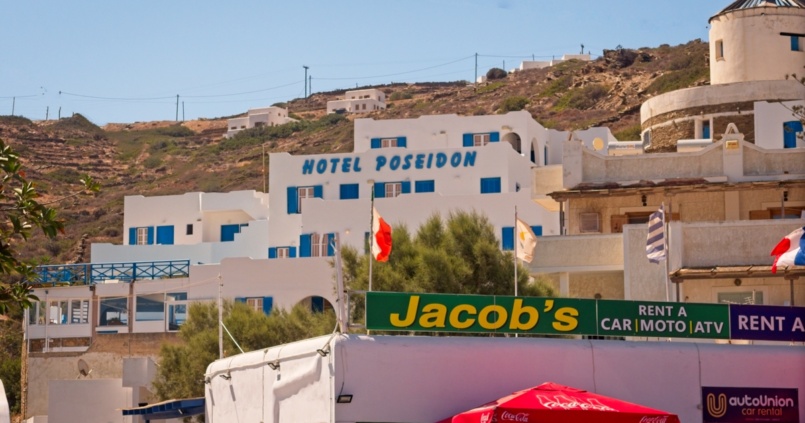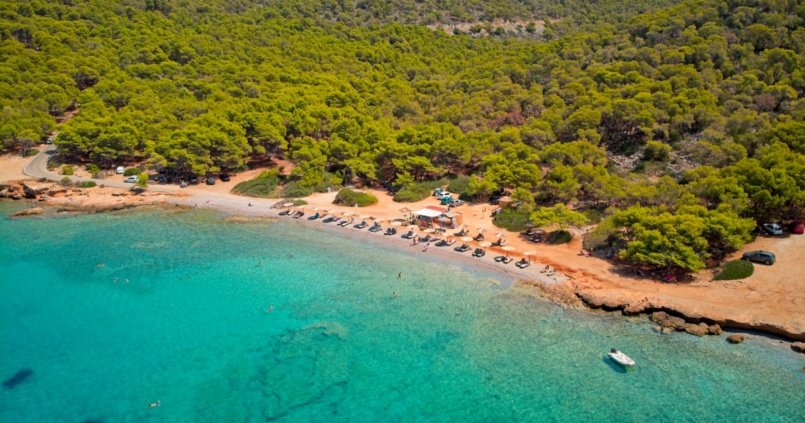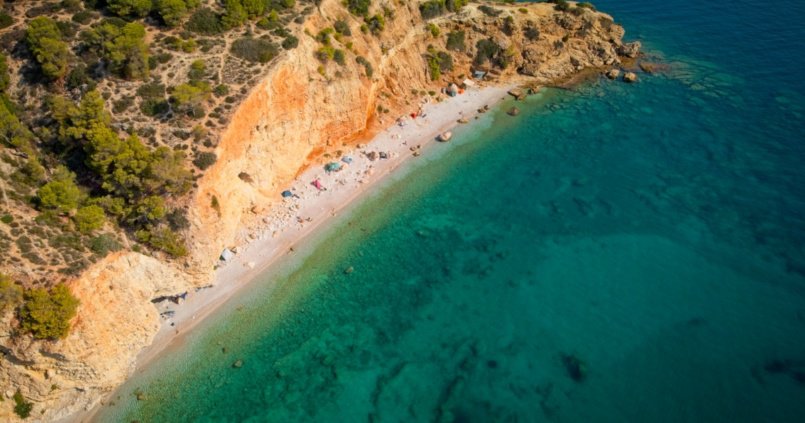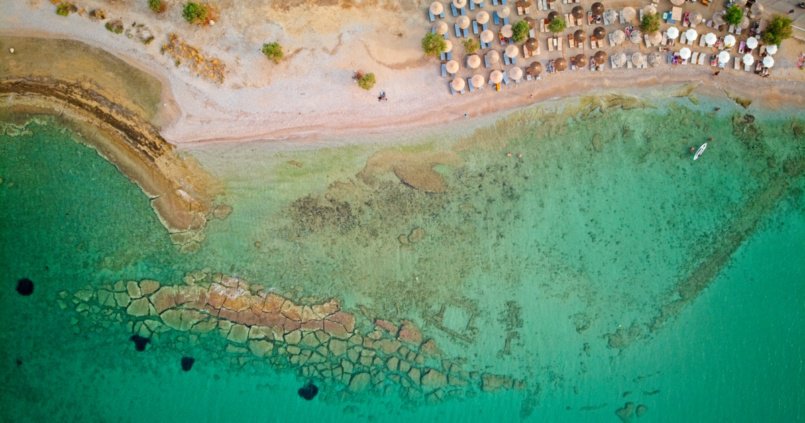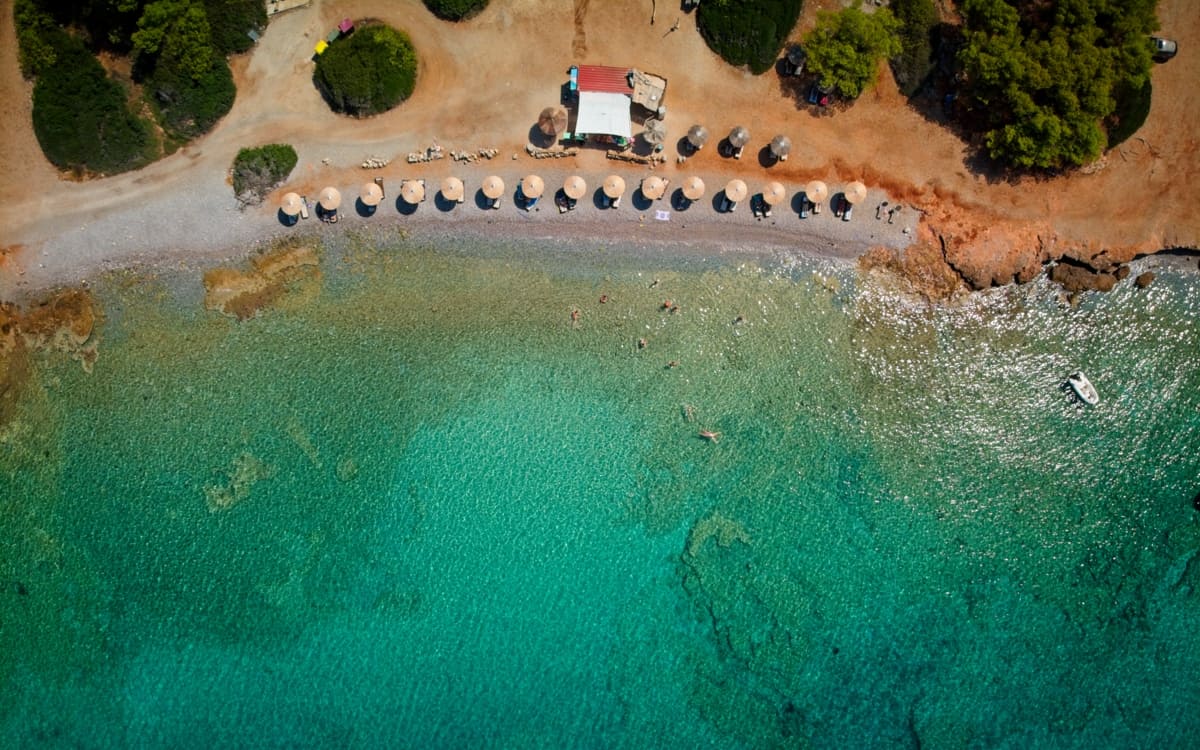
Agistri Island Guide
Agistri Island Overview
Nestled in the Saronic Gulf between Athens and the Peloponnese peninsula, Agistri is Aegina’s smaller neighbour. It offers a quieter and more laid-back Greek island experience, but one that should not be overlooked.
The island measures just 13 square kilometres, so it can be covered in a day or two and explored on foot, by bicycle, or moped. A car is almost overkill, though if you are travelling as a group or family, it may be the most effective choice.
Known mostly as a tourist destination, the island offers a small selection of pleasant beaches, hotels and restaurants and offers a very relaxed atmosphere away from the hustle and bustle of mainland Greece.
Getting to Agistri
By Ferry
Like its larger neighbour, Aegina, Agistri is easily accessible by ferry from the main port of Piraeus, with multiple daily crossings taking as little as 55 minutes. Use the search box below to find ferry options for your preferred travel date:
Most ferries travel via Aegina and as both islands are relatively compact, it can make sense to spend a few nights on Aegina either before or after Agistri, which is exactly what we did when visiting the island in 2022.
By Plane
Although you can’t fly directly to Agistri, its proximity to mainland Greece means you can fly directly into Athens International Airport, then take a short bus, metro or taxi ride to Piraeus and then use the regular ferry service to reach the island.
Where to Stay on Agistri
There are only three settlements in Agistri: Skala, Megalochori, and Limenaria. Megalochori is the island’s capital and where most residents live, but Skala is the primary tourist resort and where most ferries arrive and depart–it’s worth remembering this when planning your trip, as we prefer to stay in the port town and almost booked the wrong resort before realising that Skala was where our ferry would arrive.
Based on our experience, Skala is definitely the place to stay, with a reasonable selection of tavernas and shops and a good choice of accommodation. We visited Megalochori on our way around the island, but it seemed like much more of a residential area and less geared to tourism. Limenaria is a tiny village inland towards the south side of Agistri and has very few facilities for tourists, so I wouldn’t recommend it.
Things to See and Do on Agistri
A few minutes spent on Google Maps will illustrate the island’s lack of tourist attractions: it’s mostly just quiet beaches, small villages, and some walking paths and roads connecting them all together. The island is quite green and covered mostly with pine trees. It was recognised as a “green island” in 2011 by the Prefecture of Piraeus and the National Technical University of Athens.
Aponisos is a small, private islet to the southwest with shallow turquoise waters that make for excellent swimming and snorkelling.
Dorousa is a small, uninhabited island just off the southwest coastline of Agistri, opposite Aponisos. It is mostly known as a scuba-diving spot due to the presence of a shipwreck, the Avantis, which sank close to the island in 2004 and sits at a depth of between 17 and 48 metres.
We spent most of our time exploring the local beaches, of which Dragonera seemed to offer the best swimming and sunbathing experience. However, the beach is more shingle than sand, and the shoreline is quite stony, so it is by no means an excellent beach by general Greek standards. There is a small, sandy beach on the eastern edge of Megalochori, and while Skala has quite a large beach on its northern peninsula, I found it rather disappointing due to the coarse sand and rocky shoreline.
Chalikiada Beach, southeast of Skala, is a secluded beach popular for wild camping and as a naturist spot, but isn’t easily accessible except on foot through a patch of forest and down a steep hillside.
Agistri Video
Check out our YouTube video for Agistri:
Agistri Dining Options
We ate exclusively in Skala during our three-night stay. A reasonable selection of tavernas can be found along the beachfront road from the port towards Megalochori. We enjoyed Avli Pizzeria for dinner, Gyrokomeíon for cheap lunchtime snacks and Artórama bakery for breakfast.
Getting Around Agistri
A local bus service offers travel between Skala and Megalochori and, during the summer season, also to Aponisos, passing through Limenaria and stopping at Dragonera Beach.
The island’s compact size means it can be explored on foot: the distance from Skala Port in the northeast to Aponisos in the southwest is just over 8 kilometres by road. Hiring a bike or moped is probably the quickest and most cost-effective way of exploring without public transport. We hired a moped for two days at a cost of €25 and had plenty of time to see and enjoy all the island has to offer. A car might be more practical if you’re travelling with family or friends, but is by no means necessary to get around.
Agistri FAQ
We enjoyed our three-night stay on Agistri, though it is a very quiet island so may not suit everyone if you like to be active and do lots of sightseeing.
The most logical island to combine with Agistri is its larger neighbour, Aegina. Most ferries cover both islands as part of their regular route, so getting from one to the other is easy. Aegina is larger and has more to see and do, so it contrasts well with Agistri.
No, Agistri has no airport, so you must arrive by ferry. The nearest airport is Athens International Airport, and from there, it’s just a 45-60-minute journey to Piraeus, followed by a 55-minute ferry crossing.
We found the best beach on the western coastline at Dragonera, but it’s more shingle than sand and the shoreline is quite stony.
Yes, Agistri has a local bus that goes between Skala, Megalochori, Limenaria and Aponisos during the summer tourist season.
Although we liked Agistri for its quiet and relaxed atmosphere, we preferred Aegina as it offers slightly more as a tourist destination.
Agistri: Conclusions and Alternatives
Our visit to Agistri was somewhat of a last-minute arrangement after finding ourselves with a few days to spare during an extended visit to Greece in 2022. After spending three nights on the larger island of Aegina, we did find Agistri rather quiet and somewhat lacking in things to see and do. However, it is a peaceful island and nice to experience as a place to relax and unwind without venturing too far from the mainland.
Agistri isn’t a destination I would choose for an extended stay. I think there are nicer islands in Greece that can offer a similar or better experience at lower prices, albeit without the convenience of such a short ferry ride back to the mainland. However, it definitely has enough attraction to justify a few days, either as a short break or–as we did–part of a longer Greek itinerary.
If you’re looking for alternatives with a comparable traditional small-island feel, I’d recommend checking out Amorgos, Folegandros, Astypalea or Serifos.
Agistri Blog Posts
-
Koukounari Apartments, Skala, Agistri
Review Rating: 4/5 Website: https://www.agistriholidays.com/ Date of Visit: August 2022 Introduction tbc Location tbc Rooms TBC Service Room Facilities Although I love Food and Dining tbc Price I paid €…
-
Day 76 Agistri Part 2 – Megalochori and Dragonera
This post is part of a series called Greece 2022 Friday, 2nd September 2022 Breakfast At dinner last night, I’d spotted a decent-looking bakery called Artorama just a few doors…
-
Day 75: Agistri – Chalikiada, Megalochori, Dragonera, Livadakia and Aponisos
This post is part of a series called Greece 2022 Thursday, 1st September 2022 Breakfast Once you get used to having breakfast included at your accommodation, staying somewhere you have…
-
Day 74: Aegina Temple of Apollo, Ferry to Agistri
This post is part of a series called Greece 2022 Wednesday, 31st August 2022 Early Morning Sightseeing I planned to take the 12:40 ferry across to the neighbouring island of…

